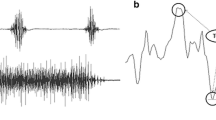Summary
Four male and four female volunteers served as subjects in these experiments to assess the frequency components of the surface EMG during and following brief (3 s) and sustained isometric contractions of the handgrip muscles. Two types of fatiguing contractions were performed. Contractions were either maintained to fatigue at a constant tension of up to 100% of their strength or were maintained as a sustained maximal effort in the unfatigued or previously fatigued muscle. The frequency components of the surface EMG were assessed by calculating the power spectra of 1.5 s samples of the EMG from a fundamental frequency of 4 Hz through the first 128 harmonics by Fourier analysis; the centre frequencies of the resultant power spectra were then used as an index of the mean frequency of the EMG. The results of these experiments showed that the centre frequency was independent of the tension exerted by the muscle during brief isometric contractions but decreased linearly with time throughout the duration of fatiguing isometric contractions at tensions between 25 and 100% MVC. During sustained maximal effort, the frequency initially decreased linearly with time. However, once the target tension could no longer be maintained, the centre frequency remained constant throughout the remainder of the contraction. The frequency was found to recover within 1 min following exercise at all tensions examined.
Similar content being viewed by others
References
Bigland B, Lippold OCJ (1954) Motor unit activity in the voluntary contraction of human muscle. J Physiol 125: 322
Broman H (1977) An investigation on the influence of sustained contraction on the succession of action potentials from a single motor unit. Electromyogr Clin Neurophysiol 17: 314–358
Chaffin DB (1969) Electromyography — a method of measuring local muscle fatigue. J Methods-Time Measur 14: 29–36
Clarke RSJ, Hellon RF, Lind AR (1958) Duration of sustained contractions of the human forearm at different muscle temperatures. J Physiol 143: 454
Eason R (1960) Electromyographic study of local and generalized muscular impairment. J Appl Physiol 156: 479–482
Edwards RHT, Harris RC, Hultman E, Kaizser L, Koh D, Nordesjo LO (1972) Effect of temperature on muscle energy metabolism and endurance during successive isometric contractions sustained to fatigue of the quadriceps muscle in man. J Physiol 220: 335–352
Fusfeld RD (1971) Analysis of electromyographic signals by measurement of wave duration. Electromyogr Clin Neurophysiol 30: 337–344
Kadefors R, Kaiser E, Petersen I (1968) Dynamic spectrum analysis of myo-potentials with special reference to muscle fatigue. Electromyography 8: 39–73
Kaiser E, Petersen I (1965) Muscle action potentials studied by frequency analysis and duration measurement. Acta Neurol Scand [Suppl] 13
Karlsson J, Funderburk C, Essen B, Lind AR (1975) Constituents of human muscle in isometric fatigue. J Appl Physiol 38: 208–211
Kogi K, Hakomada T (1962) Slowing of surface electromyogram and muscle strength in muscle fatigue. Rep Physiol Lab-Inst Sci Labour 60: 27–41
Larsson LE (1971) Frequency analysis of the electromyogram in neuromuscular disease. Electroencephlogr Clin Neurophysiol 30: 259–261
Lindström L, Kadefors R, Petersén I (1977) An electromyographic index for localized muscle fatigue. J Appl Physiol 43: 750–754
Lindtröm L, Magnusson R, Petersén I (1970) Muscular fatigue and action potential conduction velocity changes studied with frequency analysis of EMG signals. Electromyography 10: 341–356
Lind AR (1959) Muscle fatigue and recovery from fatigue induced by sustained contractions. J Physiol 147: 162
Lloyd AJ (1971) Surface electromyography during sustained isometric contractions. J Appl Physiol 30: 713–719
Lynn PA, Bettles HD, Hughes AD, Johnson SW (1978) Influences of electrode geometry on bipolar recordings of the surface electromyogram. Med Biol Eng Comput 16: 651–661
Milner-Brown HS, Stein RB (1975) The relation between the surface electromyogram and muscular force. J Physiol 246: 549
Mortimer T, Magnusson R, Petersen I (1970) Conduction velocity in ischemic muscle; effect on EMG power spectrum. Am J Physiol 131: 1324–1329
Ortengren R, Anderson G, Browman H, Magnusson R, Petersen I (1975) Vocational electromyography; studies of localized muscle fatigue at the assembly line. Ergonomics 18: 157–174
Person RS, Libkind MS (1970) Simulation of electromyograms showing interference patterns. Electroencephalogr Clin Neurophysiol 28: 625–632
Petrofsky JS (1979) Frequency and amplitude analysis of the EMG during exercise on the bicycle ergometer. Eur J Appl Physiol 41: 1–15
Petrofsky JS, Betts W, Lind AR (1977) Quantification of the surface EMG. Fed Proc 36: 1194
Petrofsky JS, Dahms TE, Lind AR (1975) Power spectrum analysis of the EMG during static exercise. Physiologist 18: 350
Petrofsky JS, Lind AR (1978) Metabolic, cardiovascular, and respiratory factors in the development of fatigue in lifting tasks. J Appl Physiol 45: 64–68
Piper H Elektrophysiologie menschlicher Muskeln. Springer, Berlin Heidelberg New York, p 126
Scherrer J, Bourguigon A (1959) Changes in the electromyogram produced by fatigue in man. Am J Phys Med 38: 148–158
Stalberg E (1966) Propagation velocity in human muscle fibers in situ. Acta Physiol Scand [Suppl] 287
Viitasalo J, Komi P (1977) Signal characteristics of EMG during fatigue. Eur J Appl Physiol 37: 111–121
Author information
Authors and Affiliations
Rights and permissions
About this article
Cite this article
Petrofsky, J.S., Lind, A.R. Frequency analysis of the surface electromyogram during sustained isometric contractions. Europ. J. Appl. Physiol. 43, 173–182 (1980). https://doi.org/10.1007/BF00422448
Accepted:
Issue Date:
DOI: https://doi.org/10.1007/BF00422448




